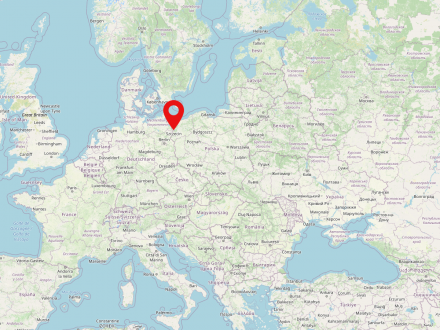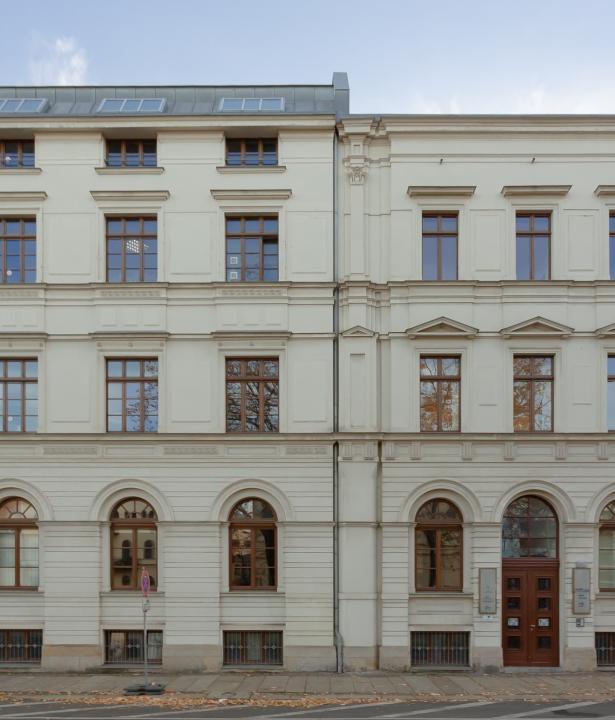14,000 years of human history along the southern Baltic coast are presented in the historical rooms of the 'Grey Monastery', built in 1845. Throughout the 1,300 square meters of exhibition space, visitors can experience up-close the culture, the life, the development of the landscape and the great political moments and movements of this region, as well as its remarkable and endearing peculiarities from the first human traces in the Paleolithic Age to the present day.
Text
In the vaulted cellar of the "Gray Monastery", you can follow the incredible 50-million-year journey of amber from its formation up to the present day. Those who are curious about the Cretaceous period can explore it in depth through our three-dimensional diorama of the Cretaceous sea. Today the legacy of this ancient time can be found along the rocky Baltic coastline. After an excursion into the early geological periods of our planet, you will emerge in an area dedicated to the ubiquitous traces of the Ice Age.


Architectural fragments of the Cistercian monastery Eldena. Pommersches Landesmuseum, CC BY-NC-SA 4.0
Architectural fragments of the Cistercian monastery Eldena. Pommersches Landesmuseum, CC BY-NC-SA 4.0


Amber cross, after 1100, place of discovery Wollin. Pommersches Landesmuseum, CC BY-NC-SA 4.0
Amber cross, after 1100, place of discovery Wollin. Pommersches Landesmuseum, CC BY-NC-SA 4.0


This brooch (250-120 BC) found in Pöglitz in Pomerania was used to close and hold together garments. Pommersches Landesmuseum, CC BY-NC-SA 4.0
This brooch (250-120 BC) found in Pöglitz in Pomerania was used to close and hold together garments. Pommersches Landesmuseum, CC BY-NC-SA 4.0
Text
In the prehistoric section, visitors can marvel at the oldest man-made tool in Pomerania or at a gold ring weighing two kilograms, a remnant from the tumultuous days of the Barbarian Invasions. The achievements of Slavic craftsmanship, the burning temple of Arkona, the rich culture of Hanseatic cities, the cabinet of the Swedish kings, a model of Harbor and an impressive collection of Baltic souvenirs will all leave a lasting impression. A highlight of the exhibition is the unique Croy Teppich, a tapestry from 1554, measuring 4 by 7 meters. This artwork, together with the regalia of the rector of University, which has been in use for centuries, testifies to the richness of Pomeranian and Saxon cultural history and shows it in a new light.
Szczecin
deu. Stettin
Szczecin (German: Stettin) is a large city in northwestern Poland inhabited by nearly 403,000 people and the capital of the West Pomeranian Voivodeship (Polish: Zachodnio-Pomorskie). Szczecin is located on the Szczecin Lagoon and borders the German states of Mecklenburg-Vorpommern and Brandenburg. The city was part of Prussia for several centuries.
Historische Orte
Pommern
Greifswald


The legendary Croy carpet from 1554. Pommersches Landesmuseum, CC BY-NC-SA 4.0
The legendary Croy carpet from 1554. Pommersches Landesmuseum, CC BY-NC-SA 4.0
Text
This is history up-close, presented in a modern and fresh way: From famous bishops and dukes to a young villager on the eve of her wedding, contemporary witnesses speak from their own unique perspectives. In the brick workshop, visitors can practice the craft of a medieval master builder, calculate figures using an abacus as a Hanseatic merchant would once have done, retrace the achievements of the Swedish surveyors, or participate in the search for the sunken city of Vineta. The exhibition is further brought to life with contemporary music scores and film sequences.
The 20th century, with its wars, multiple changes of system and huge population shifts meant perhaps the largest caesura in the region's history. Finally, the name Pomerania almost completely disappeared in the GDR. It is only in the last 30 years that the region has increasingly returned to structures that have grown over centuries. The exhibition shows the numerous facets of these breaks and continuities. In addition to important artefacts are elaborate media stations and installations, which offer access to individual topics through the lens of biography.
The 20th century, with its wars, multiple changes of system and huge population shifts meant perhaps the largest caesura in the region's history. Finally, the name Pomerania almost completely disappeared in the GDR. It is only in the last 30 years that the region has increasingly returned to structures that have grown over centuries. The exhibition shows the numerous facets of these breaks and continuities. In addition to important artefacts are elaborate media stations and installations, which offer access to individual topics through the lens of biography.


Panorama of the Hook Terrace in Szczecin with the figure of Sedina, the city patroness of Szczecin. Pommersches Landesmuseum, CC BY-NC-SA 4.0
Panorama of the Hook Terrace in Szczecin with the figure of Sedina, the city patroness of Szczecin. Pommersches Landesmuseum, CC BY-NC-SA 4.0


Under the name Stoewer, sewing machines and typewriters were produced in Szczecin, later bicycles and luxury automobiles. Pommersches Landesmuseum, CC BY-NC-SA 4.0
Under the name Stoewer, sewing machines and typewriters were produced in Szczecin, later bicycles and luxury automobiles. Pommersches Landesmuseum, CC BY-NC-SA 4.0
Text
The painting gallery spans a wide array of eras and styles, from Baroque painting with the lively portrait of a gentleman by Frans Hals or the luminous "Adoration of the Shepherds" by Gerard van Honthorst to the painters of the 20th century, who were attracted by the raw natural beauty of the Baltic Sea coast. The most special qualities of the collection, however, can be found in the 19th-century azure skies of Italy and also the newly discovered Nordic landscapes in Caspar David Friedrich. The Greifswald-born painter is represented with several works, including his famous "Ruin Eldena in the Giant Mountains." Paintings by Liebermann, Pechstein and van Gogh are also waiting to be discovered.


One of the many highlights in the painting gallery of the Pomeranian State Museum: Franz Hals "Painting of a distinguished gentleman" (1643). Pommersches Landesmuseum, Free access - no reuse
One of the many highlights in the painting gallery of the Pomeranian State Museum: Franz Hals "Painting of a distinguished gentleman" (1643). Pommersches Landesmuseum, Free access - no reuse


The picture gallery also contains some of Caspar David Friedrich's most famous paintings, here his view of "Neubrandenburg" from around 1816. Pommersches Landesmuseum, Free access - no reuse
The picture gallery also contains some of Caspar David Friedrich's most famous paintings, here his view of "Neubrandenburg" from around 1816. Pommersches Landesmuseum, Free access - no reuse


The picture gallery also contains numerous modernist works, such as the painting "Im Biergarten" (1905) by Albert Weisgerber.. Pommersches Landesmuseum, Free access - no reuse
The picture gallery also contains numerous modernist works, such as the painting "Im Biergarten" (1905) by Albert Weisgerber.. Pommersches Landesmuseum, Free access - no reuse
Externe Links
External Image






